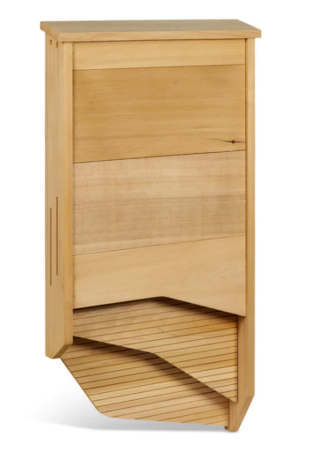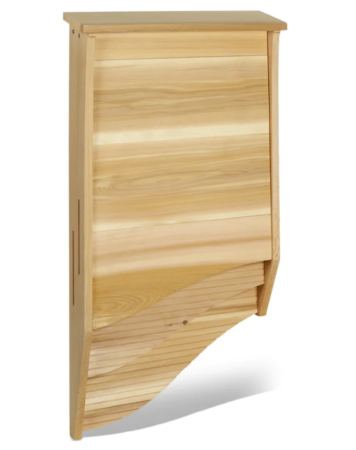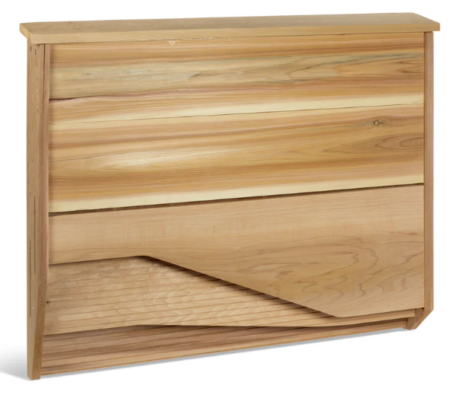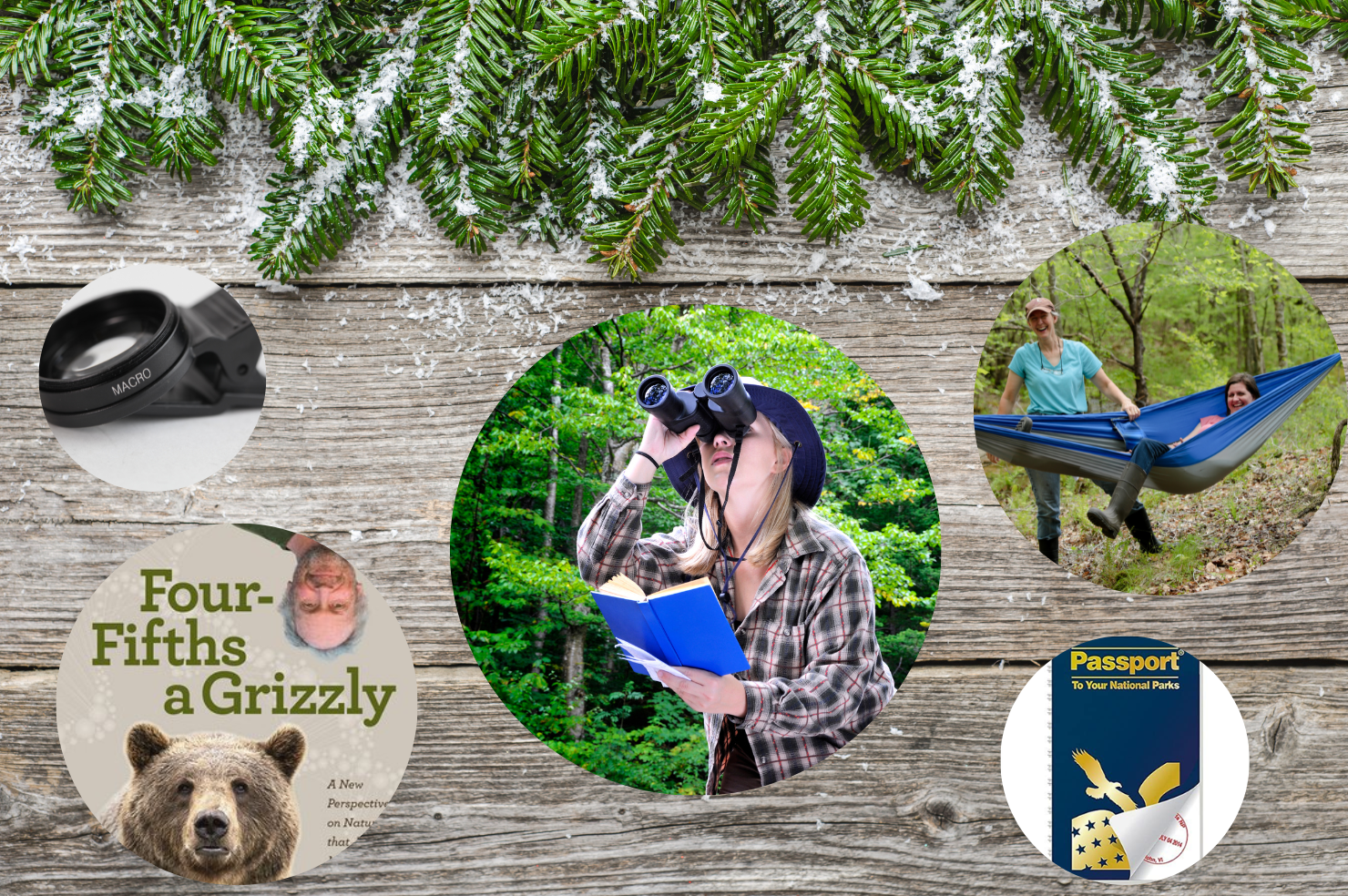People who love the outdoors often march to the beat of their own drum. While that can make for excellent conversation, it can also make gift-giving a nightmare. Whether you’re shopping for yourself or a outdoorsy person in your life, these holiday gift ideas for nature lovers will help you get started.
Below, you’ll find 12 holiday gift ideas that my naturalist and outdoor hobbyist friends have tried and enjoyed.
1. A BatBnB Bat House
Bat houses are a fantastic way to bring wildlife to your yard. These helpful animals gobble up garden pests and mosquitoes and are a great learning topic for kids. Bat houses are an increasingly popular trend in natural gardening which provide roost sites for local bats. Since bats are in trouble across much of North America, giving them comfortable places to rest can make a big difference. Bat houses are little multi-occupancy condos where bats can stay safe and dry in comfortable temperatures. This may not only attract these amazing critters to defend your outdoor spaces, but can also make a difference for local bat populations.
Although there are a lot of options out there, my favorite bat houses by a long shot come from BatBnb. This company “walks the walk” of a green brand by supporting bat conservation efforts and collaborating with bat researchers to make sure that their products are healthy and safe for bats. Their excellent educational materials, scientifically informed design, and commitment to conservation make their bat houses a holiday great gift idea for nature lovers.
They’ve got a whole host of different designs that are functional but also nice to look at. I listed a few of my favorite below. You can also learn more in my guide to bat houses. Check out the products below for 15% off through Gulo in Nature!



Larger bat houses provide room for more bats and more stable temperatures in both winter and summer. By having multiple chambers, they make it easier for bats to manage their body temperatures, a crucial part of their survival. BatBnB’s largest model is Mammoth, a super-wide option that can hold up to 240 bats!

BatBNB also carries stylish wooden signs to decorate or mark your bat houses. They also have some fantastic stickers for promoting bat conservation and spreading the love for these awesome animals.
Looking to learn more about bats? Check out these cool bat facts for the rundown on these fascinating animals.
2. An outdoor hot beverage bottle
As you’ll learn in my posts about wintertime nature, the colder seasons still have a lot to offer for nature-lovers. Although things can be a bit slower, you can discover and witness fantastic happenings in the outdoors even when things are chilly. That being said, engaging in activities like sit spots in outside spaces may require some extra preparation. Whether I’m on a day-hike, settling down to watch wildlife, or enjoying the quiet of winter woods, a good thermos of hot coffee or cocoa is always a lifesaver.
I was pretty skeptical of bringing such “extras” along in my earlier naturalist days, but one experience in New England changed my mind. In 2014, I went out to the North Shore of Massachusetts with a senior birdwatcher in late January to look for wintering Snowy owls (Bubo scandiacus). Wind chills were dipping below 0°F (-18°C), and both of my water bottles froze solid in my backpack. Fortunately for me, my more experienced companion had a full thermos of hot cocoa in his car. We warmed up with that after nearly two hours of unsuccessful searching. Though we didn’t find the owls, I had a great time watching Horned larks (Eremophila alpestris) and snow buntings (Plectrophenax nivalis), two other arctic visitors, working their way along the icy beach.
Moral of the story? Hot thermos bottles are primo holiday gift ideas for nature lovers! Even with the warmer winters I experience living in the South, they help me stay outside longer and be a bit more comfortable enjoying the outdoors during nature’s “off-season”. Here are some specific items I’d recommend:

Stanley Classic Vacuum Thermos
This is the “OG” durable hot thermos for outdoor use, and the one my birdwatching buddy had. The symbol design is rugged, not too-too heavy, and does a great job jostling around in a backpack. Absolutely my top choice overall.

TKK Large Coffee Thermos
TKK offers this heavy-duty option which comes with convenient carrying straps and a bit more disaster-proof design. It’s definitely heavier and a bit more bulky, so it may be less ideal for lengthy backpacking trips. However, it makes a lot more sense for car-camping or birdwatching, where you wouldn’t be stuck lugging it around. Like the Stanley, it’s got a stainless steel interior that is simple to clean and safe for hot beverages.

YETI Half-Gallon Rambler Jug
YETI makes some notoriously durable outdoor water bottles, and this one is no exception. The rambler jug is an excellent option if you’re looking to share your tea, hot chocolate, or coffee while you’re out there. My own YETI bottle doesn’t have the convenient handle on this model so it’s a bit more difficult to carry, but it does an amazing job keeping things warm. Next time I went owl-watching for instance, I had a YETI along and had to wait for my tea to cool down more than 5 hours later!
3. Nature journals
From Theophrastus to John Muir, great naturalists and nature-lovers have always been about writing things down. Notebooks and nature journals are a key item in any outdoor person’s go-bag. While there are some nature journals designed for specific kinds of activities, there are also plenty of all-purpose ones.
Equipped with a good nature journal, any nature lover can document their outdoor adventures to learn about the world around them and connect more deeply with nature.
Here are some great options:
- The Sibley Birder’s Life List and Journal: This is my go-to for beginning bird-lovers, professional ornithologists and serious bird-nerds alike. Like a national parks passport, this life list has designated places for the owner to check off new species as they see them. They can also record when and where they saw each new “life-bird” to preserve the memory.
- The Small Adventures Journal: This is a great nature journal for beginner naturalists or nature-curious people who are just starting out. It provides great structure with guided activities and checklists, as well as introductory materials and miniature lessons. This book is a fantastic way to connect with nature without needing grand adventures or a backpacking trip.
- The Wildflower’s Workbook by Katie Daisy. Nature’s ability to boost our mental health means that time spent outside can be more reflective and productive than hours stuck behind a desk. The Wildflower’s Workbook focuses on the introspective side of time in nature. It includes writing and reflection prompts, checklists, inspirational quotes, and thought-provoking artwork. The book encourages the journaler to connect with themselves while connecting with the outdoors.
Keeping it simple

- Rite in the Rain Notebooks: Holiday gifts for nature lovers don’t always have to be complicated. If you’re looking for a no-frills nature notebook, consider a Rite-in-the-Rain notebook. Ecologists and wildlife scientists like myself rely on these for professional field work for a reason. They’re durable, waterproof, simple, and come in a variety of sizes. I also enjoy covering them with cool nature stickers that I collect in my travels. These don’t come with any guides or instructions, so they may be better for more advanced naturalists.
Books on nature journaling
For people who are interesting in taking their nature-journaling to the next level, there are plenty of guides to keeping a nature notebook. Here are a couple of my favorites:
- Keeping a Nature Journal by Claire Walker Leslie. This great guide is already in its third edition and includes great tips and advice for drawing sketches and reflecting on form and beauty in nature.
- The Laws Guide to Nature Drawing and Journaling by John Muir Laws. Naturalist and nature educator John Muir Laws has quickly become a journaling guru among modern naturalists. His acclaimed guide provides step-by-step instructions for nature sketches and advice for improving mindfulness in the outdoors.
4. A magnifying glass or botany loupe
One of the first things many nature lovers learn outside is that beautiful things come in small packages. Having a magnifying glass, hand lens, or botany loupe opens up entire microworlds to the curious outdoor adventurer. These can make fantastic gifts for nature lovers of all ages and experience levels. Here’s my recommended option:

- Ade 10×21 Triplet Loupes: This is the size of loupe that I’ve been using for several years. It’s been a huge help in identifying insects and checking out lichens and plants. I’m also a big fan of the leather carrying case!
5. Binoculars
Seeing this up close is one thing, but there is plenty of wildlife that are best enjoyed at a distance. From birdwatching to safaris, binoculars are a fantastic option for enhancing an outdoor experience. For detailed advice on picking out binoculars as a holiday gift for a nature lover in your life, check out my guide to choosing binoculars. While a good pair of binoculars are on the pricier side, they’re absolutely a worthwhile investment. Great warranties also mean they’ll be giving years if not decades of service.
Here are some of my favorite binoculars based on my experience recommending them to friends and colleagues:

- Nikon Monarchs (10×42): These have been, in my experience, the best pair of binoculars I’ve found for under $500. They’re reliable, durable, have great optics, and they don’t give me the on-edge feeling of carrying somebody’s $3,000 Swarovski’s!

- Zeiss Conquest: These are some of my favorite binoculars that I’ve ever tried. They’re definitely up there in price, but you absolutely get what you pay for. They’re outside of my budget for now, but maybe one day! If price isn’t an issue these are a fantastic option with great warranties.

- Swarovski EL (8.5×42): If you’re going for top-of-the-line, look no further. Swarovski’s are really the top-notch birdwatching binoculars on the market in my experience. They’re solidly made with a durable exterior and parts that last, but the optics are breathtaking.
6. Outdoor hammocks
Nature adventures can be exhausting! After all, it’s well known that time outside can help you sleep better. That means having a comfy place to crash in the great outdoors is as important as getting out there in the first place. I’ve received and tried out several excellent camping hammocks which should be on your radar this season. Among holiday gifts for nature lovers, hammocks are a useful, fair-priced, and unexpected choice.
- ENO Eagles Nest Doublenest: I received one of these for my birthday several years back and am always looking for more opportunities to use it. It’s incredibly light and compact, and has room for two if you’re willing to get pretty personal. The material is easy to clean, too.


- CHULIM Double Camping Hammock: One of my birdwatching buddies uses one of these, and I like it for several reasons. It’s impressively large and spacious, which is a plus. Beyond that, it comes with an actual hanging kit which can save a lot of extra trouble. It took me a long time to find the right ropes and ties for my personal hammocks, and this sidesteps all of that.

- ENO Onelink Shelter: This is a serious hammock-shelter that some backpacker friends swear by. If you’re looking to stay off the ground and be safe from biting bugs and the elements, this is a great option. A bit more than you’ll need for casual hammock use, but comes in handy for real extended trips.

- Grand Trunk Trunk Tech Hammock: I have an older version of this hammock and love it. The carabiners are solid, the material is durable and easily washed, and it’s lightweight. I also really like the choice of colors from this brand. I keep mine in the back of my car for picnics or impromptu campfires!
Hammock straps: a useful extra
I wish I had known about these sooner! Since neither of my hammocks came with their own hanging system, I ended up buying rope and struggling with my poor knot-tying skills. Hammock straps designed for tree-trunk use are a great time-saver and companion gift for outdoor hammocks.

7. Camping chairs
While camping chairs are a luxury that hardcore backpackers probably can’t afford, they’re fantastic for shorter overnight trips and car-camping. I’ve had a wet bottom a few too many times to scoff at a good camping chair. As a field biologist, I also used them extensively when spending hours at a time studying wildlife behavior. Camping chairs can be especially useful for sit spots, another great way to connect with the natural world.

- Crazy Creek Folding Camp Chair: This is my favorite design for camp chairs, and what I used when I was working as a field ornithologist. They’re light, flexible, and don’t have a lot of parts that you can break. Although they don’t get you far off the ground, they’re comfortable and provide remarkably good back support. If I’m going to be hiking to my campsite, this is all I’d be willing to lug along with me.

- Timber Ridge Folding Camping Chair: This fancier folding camping chair has plenty of moving parts, so it’s a better choice for car camping, birdwatching, or fishing trips. These can be a lifesaver if you’re waiting for wildlife or are working from a basecamp.

- Xplorer Ultralight Backpacking Chair: This is a great “in-between” option that has a simpler design (that is, fewer things to go wrong!) but fewer creature comforts. It’s smaller and easier to pack along with you but not so bare-bones as the Crazy Creek chairs. The carrying case is also a fantastic help for portability. This would be my go to for most longer day-trips or shorter backpacking adventures.
8. Nature books
When you can’t get outside, the next best thing for enjoying nature are books about nature. Books by popular nature writers, scientists, and naturalists make fantastic holiday gifts for nature lovers. They can inspire, educate, and reconnect readers or have them look at their own backyard in a different way. While I’ll have plenty more book reviews on this blog in the future, here are a few of my favorites.
Recent books
- The Invention of Nature by Andrea Wulf: This fantastic biography covers the life and science of Alexander von Humboldt, arguably one of the Western world’s first ecologists. Largely credited with identifying concepts like biomes and the effect of elevation on climate, von Humboldt was the inspiration to Charles Darwin, among others. Wulf combines fascinating anecdotes with insightful explanations and natural history facts in this fabulous book.
- Four Fifths a Grizzly by Doug Chadwick: This inspirational book delivers the powerful perspective that all humans are inseparably intertwined with the natural world. From the microbes all over our bodies to the genes we share with grizzly bears and cucumbers, Chadwick leads us through our undeniable kinship with nature and what it means for the future. I still treasure my copy of this book and lend it to people often.
- Gathering Moss by Robin Wall Kimmerer: I can’t overstate my love for this book. Not only does it cover the natural history, biology, and cultural value of mosses, a type of wildlife I knew nothing about before reading, but it also interweaves the narrative with indigenous perspectives on nature. Dr. Kimmerer is a well-known scholar in ecology and indigenous environmental epistemology. She is a fun and engaging writer who will entertain you for hours before you realize you’ve learned more about mosses than you thought possible. A stellar read.
Also, don’t forget to check out DUET, the history of the Northern mockingbird by Phillip Hoose. You can find my review of this great new book here.
Classical nature & outdoor books
- “The Sea Trilogy“ by Rachel Carson: Although better known as the founding mother of the American environmental movement, Carson was a brilliant naturalist and marine biologist. As a bit of a landlubber, I found her three books (Under the Sea Wing, The Sea Around us, and the Edge of the Sea) hugely helpful in understanding the nature of our oceans and coastlines. The books are accessible, easy to read, and filled with scientific facts that hold up well today.
- A Sand County Almanac by Aldo Leopold: The origin of the “landscape ethic”, this fantastic book combines natural history with early thinking on ecology. It encourages readers to appreciate the value of nature, all it does for us, and what we owe it in return.
- The Life and Love of the Insect by Jean Henri Fabre: Fabre is hands down one of my favorite nature writers. A legendary entomologist who had little to no formal training, Fabre wrote beautifully about insects, arachnids, and other bugs he observed in the French countryside. His book will inspire insect lovers to look at bugs in a new light, and help others warm up to these fascinating animals.
9. Outdoor pens
Taking notes outside can be messy, rough business. Mud, sweat, and rain can stain pages or smudge ink. Drops and falls can break pens and pencils. However, for an excited naturalist, the ability to jot down some notes on the fly and have them stay there is essential.
A few years ago, a naturalist friend gave me a Space pen as a Christmas gift, and I was extremely skeptical. After several years of use, I’ve loved its durability and rain-proof ink. It makes writing in my naturalist notebook easy and convenient. I can throw it in my backpack and forget about it, and it’s there when I need it.
Here are some great pens for outdoor use:



10. Smartphone macro lens attachments
Smartphones have changed the game for outdoor photography. Mobile apps like Instagram have made it easier than ever to connect with other naturalists and share gorgeous nature photos. However, as with the naked eye, even our fantastic phone cameras have limits.
These smartphone attachments enhance our phone’s capabilities the way that magnifying glasses help our bare eyes. With them, you can achieve fantastic close-ups of entire natural micro-worlds and get a fresh perspective on the outdoors.
Here are some great options:
- Xenvo Pro Lens Kit: Their clip-on design makes it easy to attach this lens to any smartphone. What I like even more is that you can get your closeup ready in a snap. Secondly, it means you don’t have a bulky lens stuck to your phone through a long hike. Not the fanciest lens out there, but it gets the job done.

- Apexel HD Lens Set: This set comes with a wide variety of lenses for closeups, wide angles, and fisheye photographs. I’d recommend this one for the seriously artistic nature lover who wants to show display the outdoors from a wider variety of perspectives. A great tool for leveling-up the Instagram game!

11. Field guides
Guidebooks, or field guides, are foolproof holiday gifts for nature lovers. What could be more useful than a handy reference guide to the nature of someone’s favorite stomping grounds? Or a helpful text to decipher the tree-leaves and birdcalls of their next vacation destination?
If you’re looking for field guides to North American birds, check out my review of North American bird guides.
Here’s a sampling of some field guides I’ve enjoyed:
- Kaufman Guide to Insects of North America: I plucked this book off a shelf in a library in Montana several years ago and passed an entire morning thumbing through it. I bought it as soon as I could after that. A beautifully illustrated guide with lots of great natural history and background on the study of insects. I can’t recommend it enough!
- Peterson Field Guide to Mushrooms of North America: Fungi are a fascinating and mysterious part of the natural world that is too often ignored. I meet few naturalists who are experts in identifying mushrooms and other types of fungus, so this book always comes in handy.
- Peterson Field Guide to Eastern Trees: Peterson field guides are straightforward, reliable, and relatively portable. I kept this one in the glovebox of my car for a long time and it regularly came in handy! I especially like that it provides identification guides that don’t rely only on leaves, which can be a problem when trees lose their foliage in fall!
- National Audubon Society Field Guide to Reptiles and Amphibians of North America: Audubon society guides make great use of excellent photography and are chock-full of tidbits and factoids on species of interest. This one has helped me improve my snake-ID skills, which has definitely come in handy!
- Animal Tracks of the Midwest Field Guide: Keeping an eye out for animal signs is a great way to detect wildlife outdoors. However, learning to identify what you find takes practice! This book is a great way to familiarize yourself with the tracks and gait patterns (ways of walking) of a variety of North American critters.
Field guides for outside of North America
- The Birds of Costa Rica: Although not the most complete Costa Rican field guide, this one’s portable and, more importantly, durable. Through all my travels through Costa Rican rainforests for research and teaching, this book has held up the best to the dirt and humidity. It also features great accounts of natural history and explanations of tropical ecology.
- Collins’ Bird Guide to Britain and Europe: This was my birdwatching lifeline when I lived in Europe. One of the most complete and beautifully illustrated guides that I’ve ever come across, the Collins guide is fantastic for learning birds throughout the continent and the British Isles.

12. National Parks Passport
National Parks are one of the best destinations for outdoor adventures and quality time in nature. If you or someone you know is a park-hopping nature lover, a National Parks Passport will make a great holiday gift.
With information about parks in different regions and spots to collect stickers and ink visitation stamps, these passports are a great way to keep track of epic trips. They also satisfy the collector’s itch that many naturalists (including myself!) suffer from. Any national park, monument, or historical site run by the United States National Park Service will have a stamp for your passport
The official passports come in two versions, one smaller booklet and one collector’s edition. The first one worked great for me for several years, but I quickly ran out of room. By contrast, the collector’s edition is has a designated spot for each national park’s stamp. The collector’s edition is heavier and not as durable as the original, but it has loads of other great features. For example, it has more overflow pages for extra stamps, and cool factoids about individual parks.
These passports are a cheap and easy way to make park visits all the more special and memorable. Warning: collecting national parks passport stamps can be addictive! I find myself looking for excuses to get new stamps every time I travel.
National Parks Passport

National Parks Passport Collector’s Edition

Thanks for reading my 2023 guide to holiday gift ideas for nature lovers!
Did this year’s guide help you find a holiday gift for a nature lover in your life? Let us know in the comments! If you’d like to see any other products featured on Gulo in Nature, drop me a line using the Contact Page! Found this post helpful? Please support the blog by sharing with friends and on Social Media!

